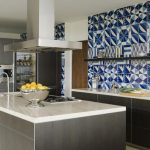Upgrading your kitchen to a contemporary style is a practical decision that goes beyond just improving its look. A modern kitchen is designed to be functional, making cooking and meal prep easier and more organized. When opting for a contemporary design, focus on clean, simple lines and clutter-free spaces. It can make even small kitchens feel more spacious and airy.
This style often includes updated appliances and smarter storage solutions, helping to streamline everyday tasks. This article discusses some of the tips on how to give your kitchen a contemporary look!
Open Concept Design
Open-concept design barriers like walls or doors make the kitchen part of a larger, open area. It’s favored for its ability to make homes feel more expansive and welcoming.
In an open kitchen, cooking and socializing can happen simultaneously, fostering a more interactive environment. This layout is especially useful in smaller homes, as it maximizes available space and brings in more natural light.
However, executing an open-concept design can be complex. It often involves structural changes, like removing walls, which requires careful planning and expertise.
For this reason, it’s crucial to involve professionals who can ensure the structural integrity of your home while achieving the desired aesthetic. Do a quick online search with keywords like best kitchen remodeling company near me to find skilled local professionals.
Industrial Accents
Industrial accents in kitchen design are all about bringing a touch of urban, warehouse-style aesthetics into your home. This design style is characterized by its use of materials and elements that you might find in old factories or industrial spaces.
For instance, exposed pipes and ducts are a common feature, adding a raw, unrefined look. The use of stainless steel, not just in appliances but also in fixtures and finishes, contributes to this style’s modern feel.
Another characteristic of industrial kitchen design is the incorporation of concrete, whether in countertops or flooring, offering a sturdy yet stylish element. Wood, particularly in its more natural, unpolished form, is also a popular choice, adding warmth and balancing the cooler metals and concrete.
Gold Accents
When used thoughtfully, gold accents can bring a sophisticated contrast, especially in kitchens with a more neutral color scheme. Small elements, such as gold cabinet handles, faucets, or light fixtures, are easy ways to introduce this metal without overwhelming the space.
These details catch the light and draw the eye, adding a subtle richness to the kitchen’s overall look. For those who prefer a more dramatic impact, larger gold features, like gold-finished appliances or countertops, can be striking.
They become focal points in the kitchen, offering a bold visual statement. Pairing gold with monochromatic cabinetry, such as black or white, creates a particularly striking contrast.
Traditional Touches
Farmhouse sinks are a prime example of this trend. These are large, deep basins; these sinks are not only visually appealing but also highly functional, perfect for handling large dishes and pots. Their classic design adds a rustic charm to the kitchen, complementing a variety of styles from modern to traditional.
Stone accents, such as natural stone countertops or backsplashes, also add a traditional touch. They bring a sense of durability and timelessness to the kitchen. Natural stone comes in various colors and patterns, allowing for customization and adding an earthy element to the space.
Material Selection
Stainless steel is a popular choice, especially for appliances and fixtures. Its sleek, shiny appearance gives kitchens a contemporary and professional look. It’s also known for its durability and ease of cleaning, making it practical for everyday use.
Quartz countertops are another favorite in modern kitchens. They come in a variety of colors and patterns, allowing for customization to fit any design. Quartz is appreciated for its non-porous surface, which makes it resistant to stains and bacteria, an essential feature for a kitchen.
Glass is often used in backsplashes or cabinet doors, adding a light and airy feel to the space. It can be clear, frosted, or textured, offering versatility in design.
Eclectic Style Fusion
Fusing eclectic styles involves blending different design elements from various eras or styles to create a cohesive yet distinctive look. For example, combining a rustic wooden table with sleek, modern chairs can create an interesting contrast. This mix of old and new can add depth and character to the kitchen.
Using color effectively is crucial. A neutral palette can serve as a backdrop, allowing statement pieces to stand out. Adding a pop of color with a vibrant backsplash or colorful appliances can also enliven the space.
Textural contrasts are another way to enhance the eclectic style. Mixing smooth, modern surfaces with rough, vintage textures can create a visually stimulating environment.
Monochromatic Themes
Choosing a monochromatic theme for your kitchen, such as all-white or full beige, significantly impacts the room’s atmosphere. An all-white kitchen creates a bright, open feel. It reflects light, making the space appear larger and more open.
This choice is popular for its clean, minimalist look, which aligns with contemporary design trends. However, maintaining an all-white kitchen requires regular cleaning to keep it looking pristine and fresh.
Alternatively, a beige palette provides a warmer, more welcoming ambiance. Beige kitchens can still be modern and stylish but offer a cozier, more lived-in feel compared to the starkness of white.
Two-Tone Cabinetry
The two-tone cabinetry concept involves using two different colors or finishes for the cabinetry, often contrasting upper and lower cabinets or the main cabinet bodies with the island. The most common approach is to pair a lighter color, like white or cream, with a darker shade, such as navy blue or charcoal gray, to create a striking visual balance.
This technique adds depth and dimension to the kitchen and allows for personalization of the space. It’s also a practical choice for those who want to experiment with color but are hesitant to commit to a single bold hue.
Decorative Island
A decorative island in the kitchen can dramatically transform the look and feel of the kitchen, offering additional workspace and storage. Islands can be customized in various ways, from the material of the countertop, such as granite, quartz, or wood, to the style of cabinetry and drawers. The design can range from simple and sleek to more elaborate and ornate, depending on personal preference and the overall kitchen theme.
In terms of functionality, islands often house appliances like dishwashers or wine coolers and can include features like built-in sinks or cooktops. They provide extra seating space, making them ideal for casual dining or socializing while cooking.
Conclusion
Transforming your kitchen with contemporary elements can significantly enhance both its functionality and aesthetic appeal. Incorporating traditional touches and eclectic style fusions adds character, while material selection and monochromatic themes define the space’s modernity.
The addition of a decorative island further enriches the kitchen’s practicality and style. Each of these elements contributes to creating a kitchen that is not only a joy to use but also a reflection of personal style.







